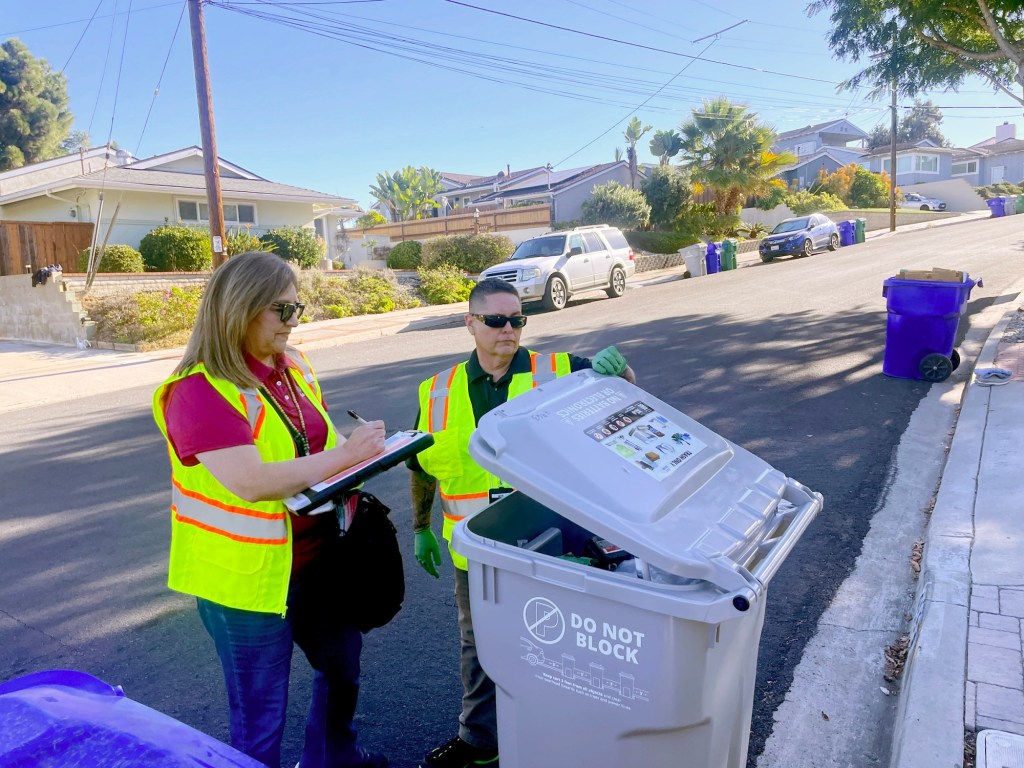San Diego has begun sending teams of trash inspectors to neighborhoods across the city to gauge whether people are using the proper bins for trash, organics recycling and traditional recycling of glass, metal, plastic and paper.
The inspectors — code compliance officers who’ve been nicknamed “lid lifters” — aren’t issuing fines or punishing city trash customers who mistakenly put the wrong items in either their gray, blue or green bins.
Focused on education instead of punishment, the inspectors place either “oops” tags on bins that contain improper materials or “do not collect” tags on bins with dangerous materials like propane tanks or lithium batteries.
Customers who get a “do not collect” tag must remove any dangerous materials and then call the city to send out a trash crew to handle the container.
The lid lifters, who conduct their inspections just before crews are scheduled to pick up trash and recycling, have created some confusion because their inspections began with the city’s trash system in tremendous flux.
Crews have begun delivering new containers to about 225,000 homes eligible for city trash service. In addition, the city continues to help secure private trash service for some of the roughly 19,000 homes deemed no longer eligible for city service.
City officials say the launch of the inspections, which began Oct. 8, is unrelated to all the other changes. They say the launch is part of the city’s transition to the next phase of its rollout of organics recycling.
The city delivered green trash containers and compost bins to customers in 2023 to comply with SB 1383, a state law that aims to fight climate change by limiting the amount of organic materials in landfills.
Methane contributes more to climate change than any other gas except carbon dioxide, according to the California Air Resources Board. It traps heat about 80 times more effectively than carbon dioxide over a 20-year period but is a short-lived pollutant.
To continue complying with SB 1383, the city must start inspecting what customers are putting in their bins and keep trying to educate those who are making mistakes.
Green bins are for yard trimmings and food waste. Blue bins are for glass, metal, paper, cardboard and rigid plastic. Everything else goes into the gray bins.
The education campaign is important because customers continue to struggle with which items can be placed in the green bins, and with how to use the green compost bins to separate food scraps from other trash, said Julie Sands, the city’s recycling program manager.
“That kind of behavior change doesn’t just happen overnight,” Sands said Monday, adding that the city’s education campaign remains in progress. “We’re in the middle of it right now.”
Customers who get “oops” tags placed on their bins also get directed to the city’s website so they can conveniently learn more.
“They shouldn’t have to spend an hour researching,” Sands said. “There is more participation the more education there is out there.”
If customers ask the inspectors what they are doing, the inspectors hand them fliers in one of four languages — English, Spanish, Vietnamese or Tagalog — explaining the new campaign.
Many other cities across California have begun deploying similar inspectors, Sands said.
And the private haulers who handle San Diego’s businesses and apartment complexes have also begun sending out inspectors, she said. The city only handles trash collection from single-family homes and multifamily complexes with four units or less.
Sands said there’s also been a public misperception that the inspectors are new hires whose only job duty is performing the inspections.
The inspections are being handled by existing code compliance officers in the city’s Environmental Services Department. They only spend a little over two hours a day on the inspections, with the rest of their day spent on other duties like making sure multifamily properties have the proper bins.
The city is devoting 12 inspectors to the effort — six teams of two. They typically work from 6 a.m. to just after 8 a.m., work that includes inspections, travel time and logging the results into the city’s recycling database.
“They are arriving at the routes before the collection trucks come — that’s why they start so early in the morning,” Sands said.
She said it was too early to give an estimate of the staffing costs for the inspections.
Another goal is keeping trash truck drivers safe and the trucks in good condition by getting dangerous items like propane tanks and lithium batteries out of the bins. Those items must be taken to household hazardous waste drop-off sites, like one the city operates at the Miramar landfill.
The batteries, which are used in laptops and e-bikes, have been responsible for 25 city trash truck fires so far just this year, officials say. When they get crushed by a trash packer, they sometimes explode into fire.
